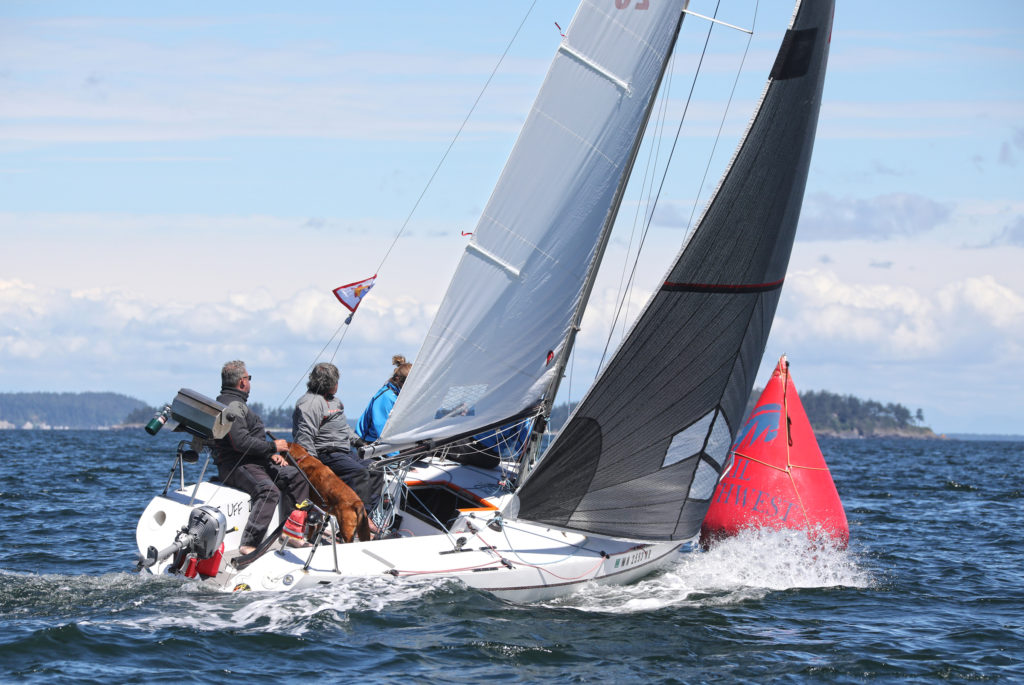
For five days in June, racers converged for the second annual regatta simple known as Race Week. The successor to the traditional Whidbey Island Race Week, the heart and soul of the event has stayed the same and continues to stand as a mainstay of the Pacific Northwest racing calendar, but with a new home in the waterfront town of Anacortes. The large, deepwater marina has plenty of room for racing boats and the occasional mother ship to dock alongside, plus the whole facility is adjacent to several city blocks of restaurants, bars, and hotels. It’s as good of a choice for a multi-day regatta as anywhere in the Salish Sea.
The event was set for a five-day format, running from June 20-24, with a posted limit of three races per day, which gave event organizers plenty of flexibility to run good and fair racing. They were able to tweak the racecourse layout and allow for more flexibility than pre-defined courses of the previous year. A solid mix of PHRF and one design fleets put the event on their calendars and a total of eleven fleets were set to go racing all week long.
The on-the-water action was on the lighter side for the first three days due to a lack of gradient breeze in the area, resulting in extremely variable and shifty conditions. Against the adverse conditions, the race committee worked their way through and eventually got off a light wind race on the first day with the breeze eventually dying later in the afternoon. Tuesday saw similar conditions in the morning, but the light breeze gave out sooner, and after a good try at waiting it out, the race committee eventually threw in the towel and sent the fleet back to the dock for the afternoon
Wednesday finally had a touch of texture on the water and things got off to a smooth start, but the sailors eventually saw the wind shut down and shift to the south. However, in a dramatic turn of events, the wind filled in and built into the low teens for the second race of the day. It was a bit of a scramble for the fleet to totally reset from light air drifting to full powered-up racing, and it certainly caught more than one team off guard. It was by far the best racing of the week so far and a huge relief for sailors, who had spent most of the past two and a half days sitting around waiting for wind. Unfortunately, the end of the day was near so only one race was held in the breeze before the fleet headed back to the dock for libations.
Finally, after three frustrating days of trying our hardest, the forecast for Thursday and Friday had wind! A steady 10-13 knots out of the northwest were in store and it filled in like clockwork in the morning. Racing got underway, and to the surprise of many, it was not the wind but the currents that were the major factor for tacticians and strategists that day. With the racecourse located amongst eight different islands, it was the absolute definition of chaos as current lines would form and dissipate on every leg of the race with no real pattern or cycle that anyone on our boat could recognize.
At the end of the week, it was a close race in every fleet, with the leading boats trading the top spot throughout. With six races in the final two days, it really began to stack up the scores and allow the consistent boats to rise to the top. Some serious standouts in their fleets were John Hoag and his team onboard the 1D35 Shrek, who took a commanding win in PHRF 1. Meanwhile in PHRF 2, Kevin Welch and his team onboard the J111 Recon maintained their lead over the 65 Red Roses by only one point for the class win. And last but not least, the phenomenal performance by the More Uffda team aboard their Moore 24 under owners Ben and Jen Braden. With almost all first place finishes except for one second place, they took the top spot with a dog and a hot BBQ onboard the entire week. They also took home the overall win for the entire regatta and as the smallest boat in the entire event, showed that they know a thing or two about how to sail that boat around the racecourse—and how to have fun while doing it.